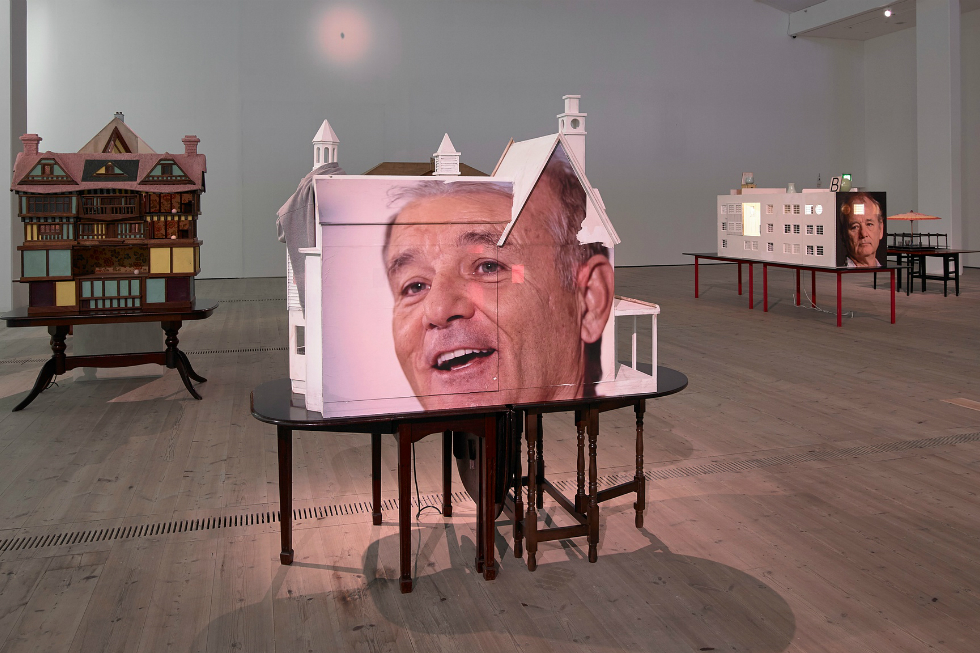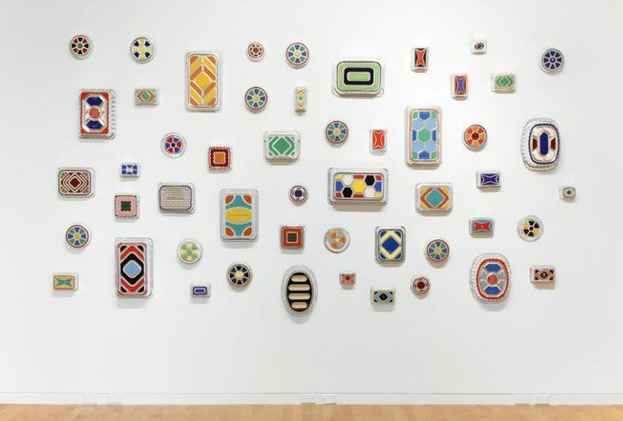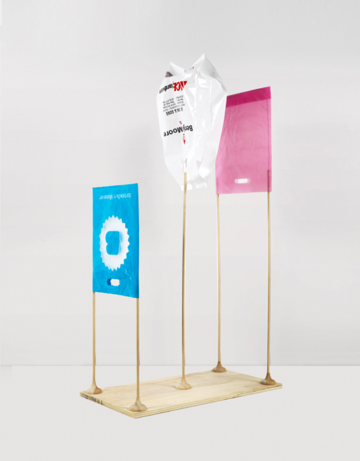Bill Murray And Modern Existence, Examined: Baltic’s Two New Exhibitions — Reviewed

Laura Harris finds new exhibitions by Brian Griffiths and B. Wurtz dally with the driftwood of modern existence, yet fluctuate between excellence and mediocrity…
Clad in a garish green checked blazer, a giant Bill Murray keeps vigil over the Tyne. The 20-meter banner gracing the Baltic’s waterfront façade shows the actor, back turned to a thicket of paparazzi, squinting through the tiny viewfinder of his tiny camera.
The Baltic’s two new exhibitions, which opened on Friday, teem with questions of scale. Brian Griffith’s Bill Murray: A Story of Distance, Size and Sincerity toys with the size of objects, teasing our presumptions about proportions. On the floor above, B.Wurtz Selected Works 1970-2015 brings together more than 60 of the American artist’s works, constituting his most comprehensive UK show and first museum survey.
Griffith’s banner is prelude to his exhibition, in which Bill Murray’s face is plastered onto meticulously crafted and rigorously detailed dollhouse-like constructs. Each structure provides a mise-en-scene which leave Murray’s exploits to be animated by the viewers’ imaginations. Griffiths considers these arrangements ‘metaphysical fantasies’ in which Murray signifies an archetypal character of the collective unconscious; the mythologised celebrity. “Bill!’ Griffith giggles; “what’s going on there?!”
Each assemblage is peppered with props and clues to aid the imagination. An LA beach house with plexiglass pool splashes reflected light onto the gallery’s wall. A gloriously kitsch cocktail-glass-shaped bedside lamp makes a fabulous luminous nightcap. Elsewhere, the aroma of fresh coffee wafts out of a window and a troop of mini whiskey bottles turn the veranda of a Scottish mansion into their stage.
Beyond mild observations about size and scale, however, the absurdity of the premise never quite teeters over into profundity. Griffith’s sincerity is uncertain, and it is reasonable to conceive that the hyperbolic nature of the show is a device with which to wrench ‘revelations’ from the viewer. Unfortunately, any such revelations – on celebrity and sincerity, authenticity and artifice – are overly prescribed and inexpertly extricated. Griffith’s fantastical landscapes never fully snag the imagination.

In comparison, B.Wurtz Selected Works 1970-2015 benefits from some charming exhibits and is a thorough introduction to the artist whose acclaim in America is not yet matched in the UK. As such, the exhibition realises curator Laurence Sillars’ dedication to showcasing artists unjustly passed over, or yet to be recognised, by the British arts scene. Having previously been shown at London’s Kate MacGarry Gallery in 2013, Baltic’s show is the artist’s first UK venture beyond the capital.
Wurtz creates sculptures and installations from the detritus of contemporary American society, like shoelaces, food wrappers and buttons. In doing so, and almost as a by-product, his works serve as a visual archive of recent US history. These unglamorous items, the flotsam of consumerism, are rarely recorded in history books; despite being fundamental to the fabric of our times, they are instantly forgettable. The objects he chooses to re-use loosely coagulate around the three main themes of his work: food, shelter and clothing. As such, Wurtz’s work deals with the most fundamental of human necessities, while dallying with the driftwood of modern existence.
The lowly carrier bag is elevated to object d’art in Wurtz’s assemblages. They hang from ladders, handles stretching down, or burst in multi-coloured fireworks of polystyrene. Elsewhere, Wurtz has strung a collection of negatives he was given, each showing supermodels on the catwalk, into a sculpture reminiscent of a weeping willow (Collection #5, 1999). At the rear of the exhibition, a wall is covered in aluminium take away trays, their undersides painted in bright colours.
Wurtz is at his most engaging, however, in his two dimensional works. In Untitled (Frame and Drawing) 1986, minimalist black line drawings are pleasing, but seemingly incongruous next to the artist’s other works. On closer inspection, however, the images are revealed to be scaled up details of the grain of the frames that encase them. Elsewhere, in Untitled (cooper coil), a mysterious black and white photograph’s uncertain subject could be anything from a Classical ruin to an immense Brutalist building. In fact, it is a detail of the strange plastic toy we soon realise is lying at our feet. These works capture the main conceit of Wurtz’s practice: the imperative to look again, to look better, to look harder.

Wurtz usurps the use value of humble, commonplaces objects, and replaces it with an appraisal of their aesthetic qualities. The knee-jerk reaction is to liken his work to Duchamp, and the two are certainly in conversation. Wurtz’s touch, however, is less starkly conceptual; he lovingly choreographs his found objects into tableaux that teases out their charm.
B.Wurtz Selected Works 1970-2015 is a fittingly understated exhibition, allowing the works to deliver their quiet message. It elucidates the main themes that Wurtz grapples with, without patronising the viewer with pre-digested conclusions. The idolisation of the mundane is infectious, and the detritus of modern life seems recast as the unjustly ignored set dressing of the contemporary stage.
Baltic’s two new shows fluctuate in merit. Nonetheless, a visit may be repaid by an imagination pricked or a newfound reverence of carrier bags. The flashes of excellence ought not to be obscured by stretches of mediocrity.
Laura Harris
See Brian Griffith’s Bill Murray: A Story of Distance, Size and Sincerity and B.Wurtz Selected Works 1970-2015 at Baltic Centre for Contemporary Art, Gateshead, from now until 28 February 2016 — FREE
Open Daily 10am-6pm; except Tuesdays 10.30-6pm. Last entry 15 minutes before closing time





